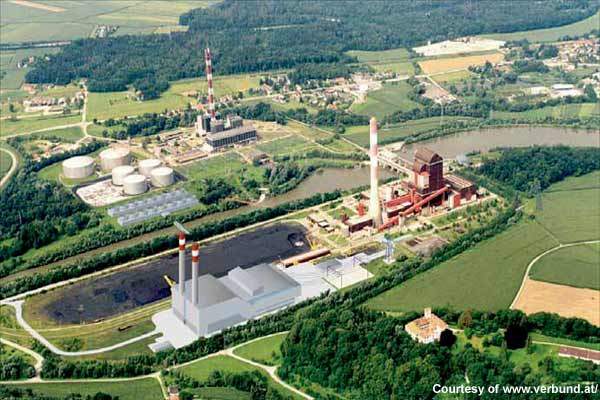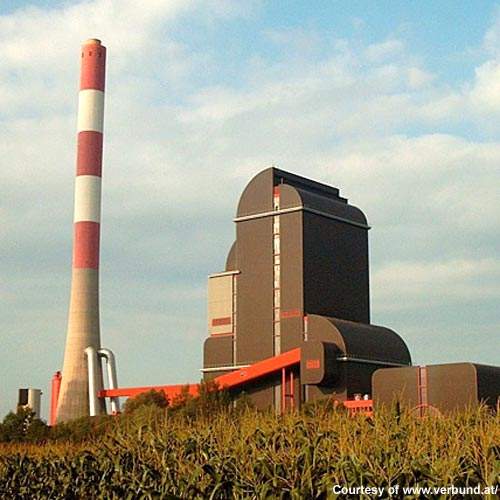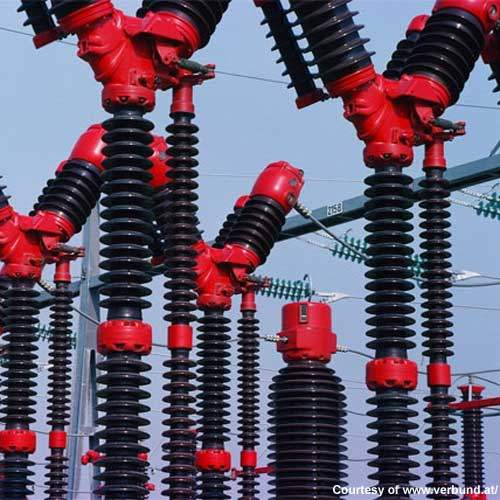The 832MW Mellach combined-cycle gas turbine (CCGT) plant is located at energy company Verbund’s Mellach site in Austria.
Owned and operated by Verbund, the thermal, gas-fired combined-cycle power plant was developed with an investment of €550m ($892.56m).
Operational since 2012, the plant also provides 400MW of district heating for the Greater Graz region.
The Mellach site previously housed a 246MW coal-fired power plant, which was retired in 2020 as part of a transition from coal to cleaner energy.
Mellach CCGT Plant Details
The Mellach CCGT plant generates power and heat without being affected by weather conditions, unlike solar and wind power plants. It is used to generate power when wind and photovoltaic power production are affected by weather-related issues.
The plant includes a building block comprising the machine and boiler house. In addition, the infrastructure includes a gas control station, switchgear and buildings for supplying cool water.
The plant design includes two machine sets, each comprising a gas turbine and downstream steam boiler with steam turbine.
The Mellach thermal plant operates at an efficiency of 59% and has an emission rating of 360t of carbon dioxide per gigawatt-hour (CO₂/Gwh).
It receives gas supply through the Südschiene gas pipeline, while the generated electricity from the plant is transmitted through the Styria line.
Sewage sludge burning at Mellach plant
The tightening of regulations with the Austrian Federal Waste Management Act greatly reduced the extent to which sewage sludge could be used on agricultural grounds. Since 1 January 2004, untreated or only drained sludge from commercial sewage plants has not been allowed to be deposited.
The combustion of sewage sludge at Mellach is a way of disposing of this. CO₂ emissions are reduced, as the sewage sludge is used as a substitute for coal. At the Fast Forward Awards 2005, ATP won the special prize for eco-technology for the project.
A test operation on sludge burning was performed at Mellach in December 2003. The drying capacity of the coal mills is sufficient for the average water content of coal and a maximum sludge amount of 1.5t/h per mill. If the coal water content rises, the sludge amount has to be reduced. The chemical and physical properties of fly ash and gypsum are similar to those without burning sludge.
Emissions from flue gas include dust, sulphur dioxide (SO₂), NOx, CO₂, polychlorinated dibenzodioxins and furans, polycyclic aromatic hydrocarbons, heavy metals, ammonia, hydrogen chloride (HCl), and hydrogen fluoride (HF). Emission parameters are below the required limits. A decision was therefore made to implement the sludge-burning project as soon as the required licences and proof of profitability were available.
The test operation started in November 2005. The sewage sludge plant consists primarily of a receiving bunker, buffer silo and dosage into the coal mills. Sewage sludge and coal are blended in the coal mills, ground and blown into the existing burners.
Mellach CCGT power generation details
Steam is generated in a steam generator through the combustion of coal, natural gas, crude oil, biomass and substitute fuels. The steam leaves the steam generator and flows through the guide and rotor blades of the turbine, which drives the generator using gear transmission. Electricity from the generator is fed into the interregional grid.
The steam that exits the turbine is converted back into water in the condenser unit. This water is then fed back into the steam generator and the water-steam cycle starts again. In co-generation plants, which produce heat and electricity, part of the steam is taken from the turbine and used to heat the water of the district heating network.
Contractors
Siemen Austria received a contract for the construction of the Mellach CCGT plant in July 2008. The project involved about 600 workers during the construction phase.
The company also delivered two gas SGT5-4000F turbines, which were built in Berlin, Germany, for the project. Each turbine has a length of 13m and weighs more than 300t.
Project background
The Mellach CCGT project was declared environment-friendly by an independent tribunal in November 2007. The ground-breaking ceremony for the project was held in October 2008.
Preliminary construction works started in the first half of 2009. The plant commenced operations in June 2012, replacing five old thermal power plants and thereby reducing CO₂ emissions by two million tonnes a year.
Verbund launched test operations for large-scale battery storage systems at the Mellach site in September 2018. The tests are part of the SYNERG-E project, which aims to create synergies between the energy (electricity transmission and storage) and mobility (electric vehicle (EV) charging) infrastructure.
In March 2021, Verbund entered a partnership with Energie Steiermark to provide district heating to more than 80,000 householders in the Greater Graz region during the 2021 to 2022 period. The heating supply was provided through cogeneration at the Mellach CCGT power plant.










